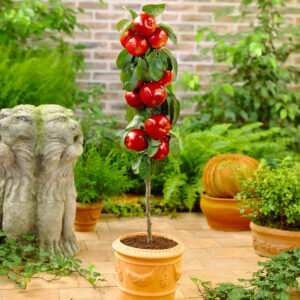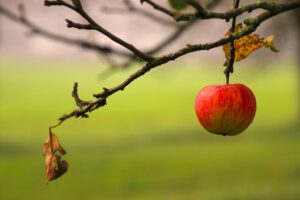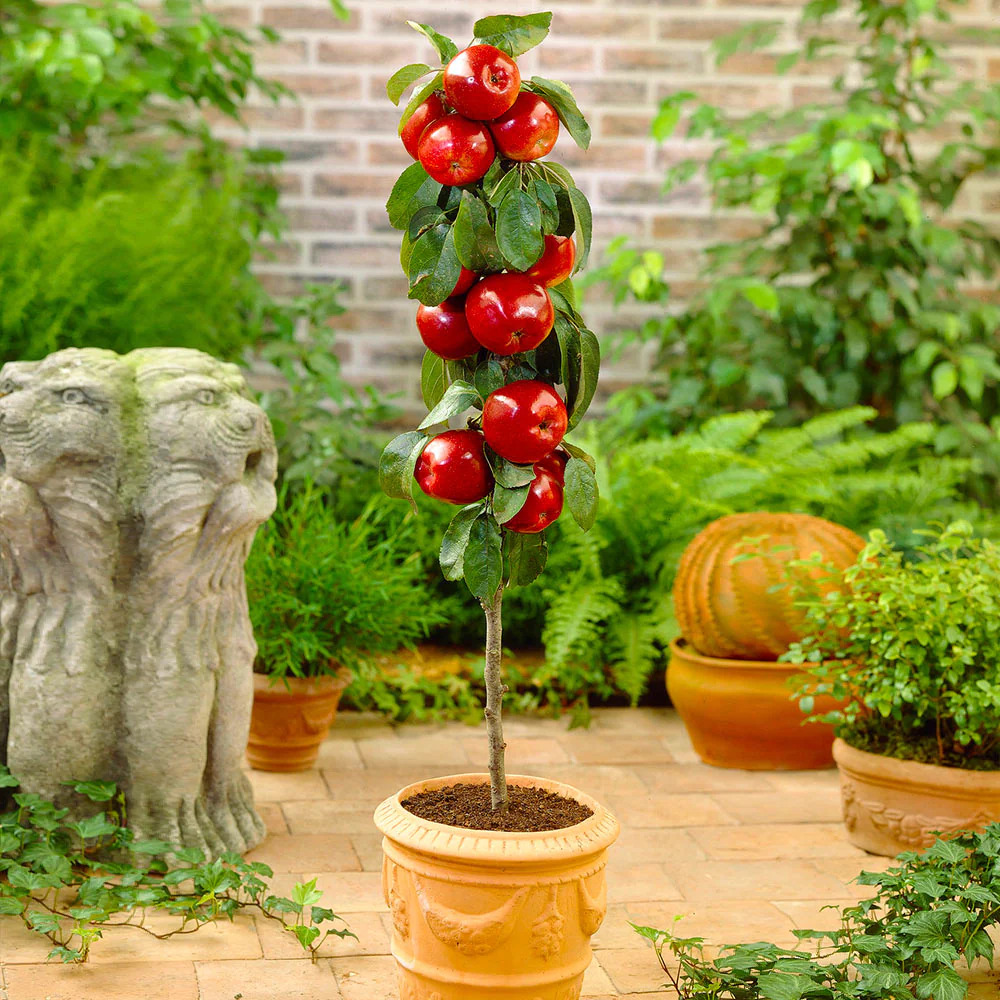Learn expert Tips for Growing Apple Trees in Pots for a fruitful harvest, even in limited space, with these essential guidelines.
Growing apple trees in pots is an excellent option for those with limited garden space or who want to enjoy fresh apples on their patio or balcony. With the right techniques and care, you can successfully grow apple trees in containers. This article provides essential Tips for Growing Apple Trees in Pots.
Learn Tips To Grow Mango Tree In A Pot
Choose the Right Apple Tree

Growing apple trees from seeds is not recommended. It is better to purchase a dwarf or semi-dwarf grafted tree from a reputable nursery. Grafting involves combining different parts of apple trees to create a new tree, which has many advantages.
- If you’re looking to buy an apple tree, you can visit a nursery or shop online.
- Look for different rootstock options like M27, M26, Bud9, G16, or M9.
- These rootstocks produce dwarf apple trees that typically don’t grow taller than 8 feet.
- You can also consider semi-dwarf trees. Choosing these types of trees allows you to grow them in containers.
Tip: Suppose you want to learn more about apple rootstock grafting. In that case, you can find helpful information on the official website of the Ministry of Agriculture, Food and Rural Affairs (Ontario).
Learn Kajari Melon Care
Consider the Chilling Period
- To produce flowers, apple trees need a yearly cold-weather period in winter called chilling.
- The chilling requirement of an apple tree is determined by the total number of hours it experiences temperatures below 45°F (7°C) but above freezing point throughout the year.
- Different apple tree varieties have an average chilling hour requirement, typically around 800-1000 hours. However, it can vary depending on the specific type you choose.
- If you live in a region with mild winters, it is advisable to select apple cultivars that have low chilling requirements.
- On the other hand, if you live in an area with harsh winters, opt for apple varieties with high chilling requirements.
- This simple approach will enhance the productivity of your apple tree when grown in containers.
Select a Pot for the Apple Tree
Avoid planting apple trees in pots that are too large initially. This can lead to overwatering and excessive moisture in the soil, which is not good for the young plant because its root system is still small.
Use a small standard-size pot that is about 5-6 gallons in size, with dimensions of 10-12 inches deep and wide.
Tip: As your apple trees in pots grow, upgrade to a slightly larger pot each time. Once it reaches the desired height, no more pot changes are necessary. A 20-25 gallon pot will be enough as a final size. However, regular pruning and occasional root trimming will be needed to keep it well-maintained.
Learn Papaya Tree Care
Pollinating Apple Tree
Most apple tree varieties require cross-pollination to produce fruit. If you have limited space and can only grow one apple tree, choose a self-pollinating variety or a tree that has a compatible pollinator nearby. Some apple tree varieties, like ‘Golden Delicious’ or ‘Braeburn,’ are self-pollinating, while others require a different apple variety for cross-pollination.
Find Is Pineapple a Berry or Citrus Fruit?
Tips for Growing Apple Trees in Pots

Location
Apple trees in pots, just like other fruit trees, enjoy growing in sunny areas. However, if you live in a warm region like USDA Zone 8-10, it’s a good idea to move the apple tree container to a shaded spot during hot summer days. Find a sunny location that isn’t too windy.
NOTE: Additionally, it’s important to ensure that there is proper air circulation around your apple tree. If you’re growing it on your balcony or rooftop garden, avoid placing it too close to the walls.
Soil
Apple plants like to grow in soil that is deep, fertile, and well-draining. While growing an apple tree in a container, use a potting mix that has plenty of organic matter and a slightly acidic to neutral pH (around 6-6.8).
You can add compost or well-rotted manure to make the soil richer for your apple tree to grow in.
Water
When growing apple trees in pots, it’s important to water them regularly, especially during the first year. Water deeply so that the roots can grow healthy. However, reduce watering in winter.
One common reason why apple trees in pots die is because of root rot caused by soil that is too wet. Avoid overwatering the tree repeatedly to prevent this from happening.
Additionally, it’s best to avoid watering the tree from above, as this can make the leaves damp and encourage the growth of powdery mildew.
Temperature
Apple trees need a cool winter and a moderate summer to grow well. They can’t thrive in areas where the temperature stays the same or becomes very hot.
However, you can successfully grow apple trees in places where the temperature gets cold. They are able to handle freezing climates by becoming dormant during the winter.
Learn Tips to Grow Baby Corn in Pots
Apple Tree Care

Fertilizer
When your apple tree is young, feed it with a balanced liquid fertilizer. Dilute the fertilizer to a quarter of its strength and apply it every 2-3 weeks during the growing season.
As the tree gets older, switch to using a fruit fertilizer. Start reducing the frequency of feeding in late fall, and stop fertilizing during winter. Wait until the warm weather arrives in spring before you begin fertilizing again.
Repotting
After about a year or two, repot the young plants. When transplanting, choose a pot that is one size larger. Before transplanting, gently scratch and spread the roots from the sides and bottom of the root ball.
Overwintering
While growing apple trees in pots, it’s important to protect the roots during harsh frosts and extremely cold temperatures. You can do this by wrapping the container with bubble wrap or by moving it to a place that provides insulation.
Pruning Apple Tree
- A dwarf apple tree requires less pruning compared to a semi-dwarf or standard-size tree.
- Pruning is necessary to manage the shape and size of the tree.
- From time to time, you should remove branches that are dead, damaged, or diseased.
- It’s also important to prune branches that are crossing each other or growing toward the center of the tree.
Note: Late winter and spring are the best times for pruning, while well-trained trees may require light pruning in the summer. Also, read this useful article from Cornell University on pruning.
Pests and Diseases
When you are growing apple trees in pots, they can be affected by various pests and diseases, such as aphids, moths, apple blossom weevils, scabs, powdery mildew, and brown rot. Here are some common ones:
Aphids: These tiny insects feed on the sap of the apple tree and can cause leaves to curl and distort. Regularly check for aphids on your tree and use insecticidal soap or a strong stream of water to get rid of them.
Powdery Mildew: It is a fungal disease that looks like a white powdery coating on leaves, stems and fruit of apple trees. To control it, make sure there is enough air movement around the tree. Apply fungicides like products containing sulfur regularly.
Apple Maggot: These small, pale larvae make holes in apple fruits, leave trails and cause the fruit to drop prematurely. Sticky traps and targeted insecticides can help control the apple maggot population.
Fire Blight: It is a bacterial disease that causes blackened, dead branches on apple trees. Prune affected branches promptly, disinfect tools between cuts, and use copper-based sprays during the dormant season as a preventive measure.
Codling Moth: The caterpillars of codling moths burrow into apples, leading to internal damage. To prevent infestations, use traps with pheromones to monitor adult moths and apply insecticides at the right time to control them.
Apple Scab: It is a fungal disease that causes dark, scaly lesions on the leaves, fruit, and stems of apple trees. For prevention, choose apple tree varieties that are resistant to the disease. Additionally, apply fungicides containing copper during the growing season.
Note: Apple tree care in pots is easy and manageable. You can easily watch out for pests and diseases and take the right actions in time.
Learn Tips on Growing Cucumbers
Picking Flowers and Fruit Thinning

Dwarf apple trees usually start to produce flowers in about 2 to 3 years. When they bloom for the first time, it’s best to remove all the flowers. This helps the tree focus its energy on growing stronger instead of producing fruits.
To have better-quality fruits, it’s important to thin them out. Wait for a few weeks after the fruits start to form, then remove the ones that are growing too close to each other. This gives the remaining fruits more space to grow and develop properly.
Learn Growing Watermelon in a Pot
Harvesting Apple Tree

It takes about 3 to 7 years for an apple tree to grow and produce fully ripe fruits.
- When it’s time to harvest, you can check if the apples are ready by picking one and giving it a taste.
- If it tastes good, then the rest are likely ready too.
- To pick the apples, don’t yank them off the tree forcefully, as it could harm the stem.
- Instead, gently twist them in a rotating motion.
If you want to store the apples, you can keep them in the refrigerator for around 6 to 8 weeks. But honestly, freshly picked apples taste amazing, so feel free to enjoy them right away by munching on them every day. They’re delicious!



